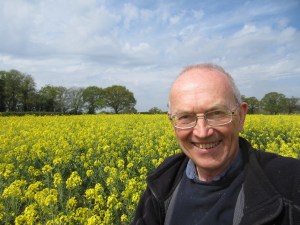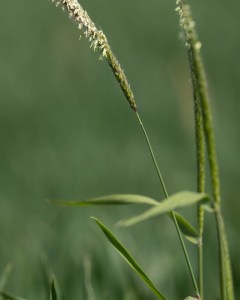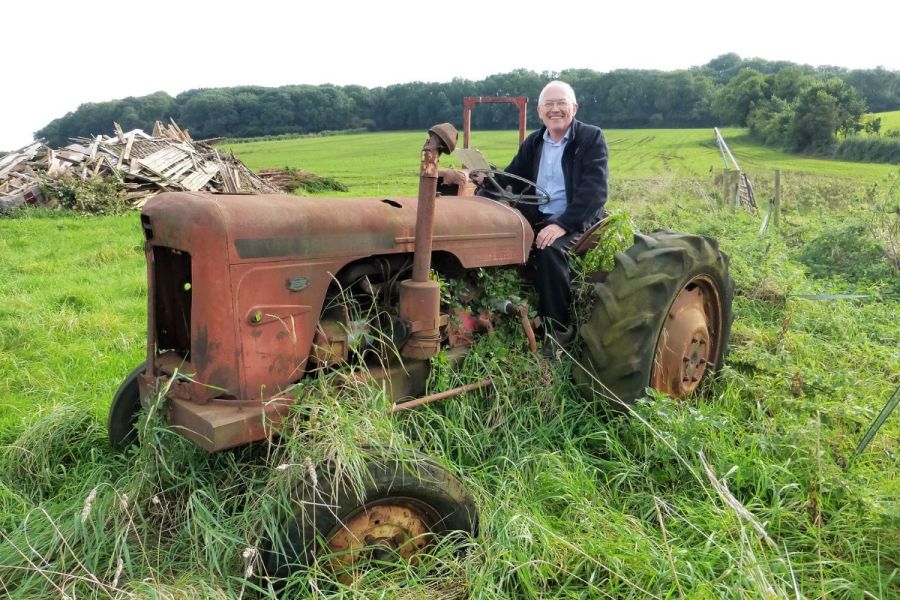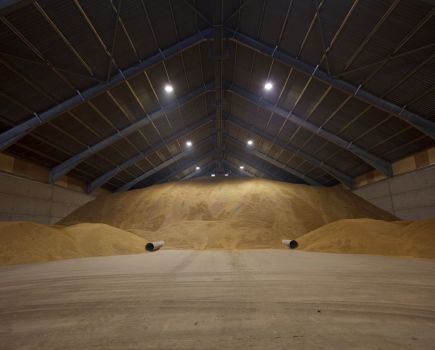If there’s anyone that’s synonymous with blackgrass, then it has to be Dr Stephen Moss. As he marks his 50th year as a researcher, CPM looks back at his career and the changes that have happened since he began his working life in 1972.
“There is a problem taking academic work through to application without the middle step – where applied researchers work on its translation to a field situation.”
By Lucy de la Pasture
Mention the word academic and you can almost see Dr Stephen Moss cringe inwardly as he starts to make the distinction between research in academia and applied research. He’s firmly planted amongst this second group of researchers, who translate the endeavours of academics into workable solutions for farmers.
When Stephen was born in 1950, the country was recovering from World War II and rationing was still in place. Farmers had the biggest job on earth and were encouraged to ‘Dig for Victory’, with government the buyer of produce until rationing ended in 1954. In those days government was wholly behind British farmers and put in place a vast infrastructure of research institutions, experimental husbandry farms and research units to give farmers the science-based advice they needed to increase productivity.
Keen to become involved in this important work, Stephen took a different career path to his parents, who were both teachers, and set about gaining a year’s practical experience which was a prerequisite to his Agriculture Hons degree course at Wye College in Kent.
“I did this on a 180ha mixed farm near Weston-Super-Mare with a 100-cow milking herd, beef enterprise, a sheep flock and some arable, mainly cereals. This was undoubtedly the hardest year’s physical work I have ever done,” he smiles.
Having graduated, Stephen started his career as a researcher at Rothamsted Research, the same institution he ‘retired’ from in 2015 – though his work continues to this day as a consultant and it’s doubtful that his relationship with the weed that has been the hallmark of his career will end any time soon. But even though his career went full-circle, Rothamsted wasn’t always his working home and blackgrass wasn’t always his nemesis.
Stephen’s research life began as a nematologist, studying the control of potato cyst nematode by the then recently approved nematicides, Temik (aldicarb) and Vydate (oxamyl).
“It was a good grounding,” he says. “It wasn’t just the experience I gained in the numerous field trials across East Anglia and Lancashire, but also working with farmers. I learned that they were very different to one another in their technical competence and the way they did things.”
Finding nematodes “rather boring”, Stephen applied for a job at the Weed Research Organisation (WRO), near Oxford, in 1975. “I thought weeds sounded more interesting, so I applied for a post which had been set up to study the response of blackgrass to changes in tillage systems. It was thought at that time that the trend to reduce tillage was linked to an increase in blackgrass problems,” he explains.

Stephen Moss recently visited the farm where he worked his pre-college year and became reacquainted with his old workhorse, the David Brown now rusting in field.
The research was supposed to include volunteer cereals and Poa spp., but that never happened. “I’d need another lifetime for that,” he jests. Since Stephen became closely acquainted with blackgrass, it has kept him pretty busy for nearly 50 years. And it was while he was at WRO that the first serious case of herbicide resistance was confirmed at Peldon, in Essex, during 1984.
At about the same time, the political changes in support for food production began to be felt and the vast network of applied research facilities, that had backed farming since the war, began to feel the pinch. In 1986, the WRO was closed down and Stephen was transferred to Long Ashton Research Station, before being moved again in 1990 to Rothamsted where he continued his work on what was fast becoming the UK’s most troublesome weed.
It was the beginning of a slippery slope for applied research, something that Stephen views as a vital interface between farmers and academia because of the danger that research findings become “lost in translation”. It’s a situation that has been mirrored in medicine and is known as the research ‘valley of death’.
“A published paper by Seyhan in 2019, describes the preclinical/clinical divide in medicine. He describes ‘a rift that has opened up between basic research (bench), clinical research and patients (bed), and this rift is widening and getting deeper’.”
Seyhan concludes that the crisis involving the ‘translation’ of basic scientific findings in a laboratory setting into human applications and potential treatments is widely recognised both in academia and industry.
Replace the words ‘medicine’ with ‘farming’ and ‘patients’ with ‘farmers’ and the same applies to agriculture, says Stephen. “My greatest achievement is surviving in the ‘valley of death’ for 50 years.”
So while there’s a recognition that there has been a massive decline in independent applied agricultural research in the past 50 years, it’s not just the loss of institutions. It’s also the sources of funding that have changed – as government reigned back spending, commercial companies took up some of the slack, points out Stephen.
Even so, it’s increasingly difficult for applied researchers to get funding for truly independent work. “In ‘valley of death’ type research, it’s viewed as ‘too applied’ by funders of basic science but viewed as ‘not applied enough’ by funders of applied research.”
Stephen acknowledges there’s still a lot of relevant applied research going on, but he says it’s hard to get an impartial view on its value as it’s often linked with commercial interests. “Just as athletes have to be careful not to upset their sponsors, so do researchers, and they also don’t have full control over how their results are presented.
“But there’s also a problem taking academic work, which is disconnected from practice, through to application without the middle step – where applied researchers work on its translation to a field situation and find out whether it’s actually relevant to farmers or not.”
He cites herbicide dose rates as a case in point. “Academic research shows that low herbicide doses encourage resistance and it’s a message commercial companies are keen to promote. But when it comes to translating this research to use in the field, it’s apparent that the academic studies are often flawed and make naïve assumptions.
“In practice, herbicides rarely give 100% kill and there’s no good evidence that low doses encourage resistance in practical farming situations. In Denmark, low doses have been heavily promoted along with integrated cultural controls, yet it doesn’t have as big a problem with herbicide resistance as we do. In the UK, we’re actually now adopting a similar approach by using a stack of relatively low efficacy, pre-emergence herbicides with different modes of action, combined with cultural controls.”
Based on the evidence he’s seen in the field over his career, Stephen is happy to put his head above the parapet and say that low herbicide doses don’t automatically encourage resistance. “The concept that they do is simplistic and misleading at the very least,” he says emphatically. “A possible exception is glyphosate, where reduced rates may increase the risk.”
It’s not the first time Stephen has been at odds with some of the agchem industry during the course of his career. In 1989, when formulating information about resistance for the Weed Resistance Action Group, it was said in a meeting that ‘resistance is the least likely reason for herbicide failure’.
It was a common view at the time. Soon after fenoxyprop-p-ethyl was introduced in 1990, someone in a senior role at a manufacturer told him that ‘taxpayers’ money shouldn’t be wasted on paying people like you to study such a minor issue as herbicide resistance’.
Stephen reflects that now virtually every blackgrass population is resistant to fenoxaprop, though rare exceptions do exist. “Perhaps companies sometimes need saving from their own myopic view. This short-sightedness means that resistance risk is sometimes dismissed for their own short-term commercial gain. It’s still an issue now and isn’t being challenged enough, but it’s not an approach that’s advantageous to farmers, or indeed agchem companies themselves, in the longer-term,” he says.
That’s not to say that attitudes haven’t changed a lot over the past few decades. In the early days when Stephen began to advocate delayed drilling and cultural controls for blackgrass, he met resistance from farmers too.

Stephen’s career has been synonymous with blackgrass; from when it first became a problem and the development of herbicide resistance, to developing cultural strategies to control the grassweed.
Thirty years ago, Stephen was once told he was talking nonsense at a farmer meeting. “I was told that promoting delayed autumn drilling and spring cropping for grassweed control is stupid advice – it’s impossible on heavy land,” he recalls. “But the ‘impossible’ became ‘possible’ because there was no alternative.”
Stephen’s place of work isn’t the only thing that went full-circle during his career. Looking back, he notes a return to what was considered good practice when he was studying agriculture at university.
“Fifty years ago, best practice was sowing winter wheat in mid-October. It was considered ideal to establish 250-300 wheat plants/m2, apply herbicides at 225 l/ha (better than 100 l/ha); spray at <12 km/hr (avoid excessive speed); rotational grass was good (then known as alternate husbandry); and fertiliser was applied at drilling (combined drilling).”
Stephen isn’t saying all the old ways are the best ways but believes there are salutary lessons to learn from looking back. “I think it indicated that we shouldn’t be too clever and disregard good husbandry just because it’s perceived to be old.”
He also feels optimistic for the future. “There’s a lot of very good, entrepreneurial farmers who have a realistic view and a long-term outlook. It’s a shame that they’re not supported by better independent translational research.”
Stephen is nonetheless a fan of farmers conducting their own research, facilitated by independent groups such as Innovative Farmers and BOFIN. “More farmer involvement in trials on their own farms is to be welcomed but it has to be recognised that are limits to what individual farmers can be expected to do and how information is stored and communicated long-term.”
Stephen remembers the time when ADAS leaflets were the go-to for information and reflects that independent research information is now harder to find and bring together, even though, in theory, the digital era should make it easier.
He recalls a recent RASE bulletin where Rupert Harlow of Yagro highlighted exactly this after joining from another industry. “In his article, Rupert rather tellingly said that ‘there is a huge amount of information and research, but it’s spread out, with multiple research bodies each producing information, which is scattered in different formats in different places, uncollated and therefore nigh on impossible for most to compare with any accuracy or impartiality’.”
He went on to suggest this information was collated, structured, and used to produce analytics for all farms using a tool that can ingest data from any source, across the industry, says Stephen.
It’s a sentiment he very much agrees with. “Accessing this information is an issue as it’s all over the place – if it exists in the public domain at all. This piecemeal approach has to brought together. There’s a culture that everything has to be new, but a lot of the information collected in the past is still relevant now so we shouldn’t be reinventing the wheel,” says Stephen.
“Rupert goes on to say that understanding the previous performance and having that research available in one place saves a huge amount of time, as well as helping build a clear understanding of the crop. He suggests it would enable historical analysis to find better approaches, spot trends and inconsistencies, and plan future seasons.”
It’s a palpable bugbear for Stephen that some applied research may be lost forever as those responsible for it retire from the industry, effectively taking their knowledge with them. It’s particularly important as he believes that some of this research could be helpful in tackling some of the problems being faced today.
The thread that has been strongest throughout Stephen’s career is his desire to carry out research that’s directly relevant to practical farming and that’s led him to work right at the interface of research and farmers. During his working life, he’s produced over 250 published papers but that’s far exceeded by the number of his contributions to articles in the agricultural media where he helps transfer his work into meaningful guidance to farmers.
And it’s this relationship with farmers that’s particularly appreciated by Stephen. “Blackgrass has been very good to me,” he smiles. “But I’m grateful for the productive relationship I have had with virtually all the farmers, agronomists, agchem personnel, researchers and journalists throughout my 50 years in applied research. And that also extends to Defra for funding the bulk of my research during that period,” he says.
It sounds like a farewell, yet there’s a distinct impression that Stephen isn’t yet done with blackgrass, or blackgrass done with him, even if his award-winning allotment is beckoning more strongly these days…
This article was taken from the latest issue of CPM. For more articles like this, subscribe here.




